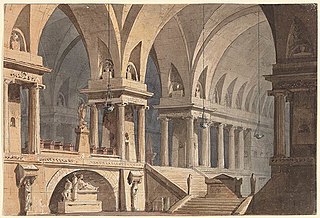
Simon de Vlieger was a Dutch painter, draughtsman and designer of tapestries, etchings, stained glass windows. While he is mainly known for his marine paintings he also painted beach scenes, landscapes and genre scenes.

Carlo Innocenzo Carlone or Carloni (1686–1775) was an Italian painter and engraver, active especially in Germany.

Giulio Quaglio the Elder was an Italian painter of frescoes. He was a follower of Tintoretto. He is known to have worked in Vienna, Salzburg, and Ljubljana.
Giovanni Maria Quaglio was an Austrian stage designer of Italian extraction. He worked mainly in Vienna, where he designed the original production of Christoph Willibald Gluck's Orfeo ed Euridice in 1762. He studied in Rome and Milan.
Lorenzo Quaglio was a German stage designer of Italian extraction. He worked mainly in Mannheim and in Munich, where he designed the first production of Mozart's opera Idomeneo.

Simon Quaglio (1795-1878) was a German stage designer of Italian extraction. He worked mainly in Munich, and was among the first designers to use built scenery instead of painted flats. He designed over 100 productions during his career.
Eugen Quaglio was a German stage designer of Italian extraction. He worked mainly in Berlin and Prague.

Michele Marieschi or Michele Giovanni Marieschi, also Michiel, also known as Michiel, was an Italian painter and engraver. He is mainly known for his landscapes and cityscapes (vedute), or views, mostly of Venice. He also created architectural paintings, which reveal his interest in stage design.

Giuseppe Quaglio was an Italian painter and stage designer, active in scene painting in Mannheim, Frankfurt, and Ludwigsburg.
The surname Quaglio belongs to a large family of artists, both painters, architects, and scenographers, originally from Laino, between Lake Como and Lake Lugano. They were active mainly from the 17th to 20th century, both in Italy and in Austria and Germany. They include:
Angelo Quaglio (1778–1815) was an architect, scenic designer, and painter born into the Quaglio family of artists. He was the eldest son of Giuseppe Quaglio. He designed and painted landscapes and architectural pictures for Boisserée's work on Cologne Cathedral.
Giovanni Maria Quaglio the Younger (1772–1813) was an Italian architect, painter, and stage designers active in Munich, member of the large Quaglio pedigree. He was born at Laino. He studied at Rome, Naples, Milan, and Venice, and became in 1793 court scene-painter at Munich. He was the son of Lorenzo Quaglio the Elder.
Lorenzo Quaglio the Younger was a genre painter and lithographer, born in Munich in the Electorate of Bavaria to the long Italian pedigree of Quaglios.

Domenico Quaglio the Younger was a German painter, engraver, stage designer, and architect. He was the second son of Giuseppe Quaglio and part of the large Quaglio pedigree of Italian artists involved in architecture, indoor fresco decoration, and scenography for the court theatres. He was known as a landscape and architectural painter/decorator, including quadratura.

Giulio Quaglio the Younger (1668–1751) was an Italian Baroque painter. He was part of the large Quaglio pedigree of Italian artists involved in architecture, indoor fresco decoration, and scenography for the court theaters. He was born and died in Laino, a mountain village at Como. Giulio II was involved in fresco decoration in Friuli, including for the chapel of Monte di Pietà at Udine. His most highly valued work is the painting of Saint Nicholas' Cathedral in Ljubljana. He also painted the central hall of Meerscheinschlössl in Graz. He had two sons, Domenico and Giovanni Maria Quaglio.

Michael Neher, the son of Joseph Neher, a citizen and painter of that city, but of a family from Biberach. Michael received a classical education, and was instructed in the rudiments of painting by Mitterer, and in 1813 entered the Academy at Munich. From 1816 to 1818 he studied under Matthias Klotz, and was then employed by Angelo Quaglio in his theatrical work. After having worked for some time as scene-painter at the Court Theatre, he went to Trento, Milan, and Trieste, and painted portraits. In 1819 he was encouraged by Hieronymus Hess, at Rome, to devote himself to genre painting. On his return to Munich in 1823 he became Conservator of the Art Union. In 1839 he painted several saloons in the Hohenschwangen Schloss, after sketches of Schwind, Gasner, and Schwanthaler. He, however, in 1837 devoted himself entirely to architectural painting, and travelled for improvement on the Rhine, and in Belgium. He was received an honorary member of the Academy at Munich in 1876, and died there in the same year.

Franz Quaglio was a German painter from a branch of the Quaglio painting family that had settled in Munich during the 18th Century.

Giulio Quaglio III was a scenic designer and architect from a branch of the Quaglio family of artists that moved to Germany in the 18th century and was the last to be born in the family's home town.
Karl Gatermann, typically referred to in art circles as Karl Gatermann the Younger, was a German painter, graphic artist, and set designer. He was the nephew of his namesake, Karl Gatermann, also an artist.

Anton Brioschi was an Austrian painter, scenic designer and graphic artist. His non-theatrical works were mostly landscapes and marine art.












